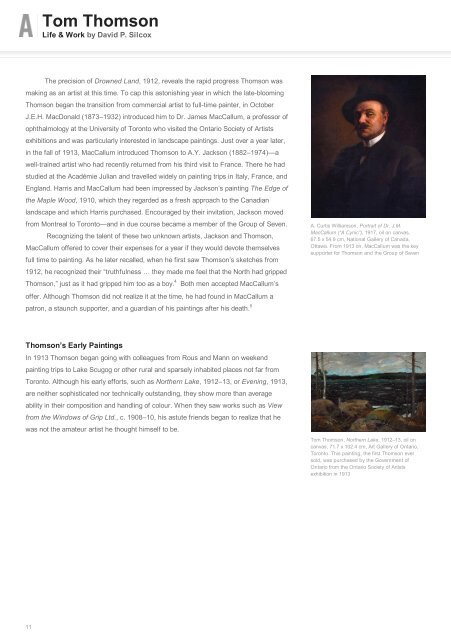Create successful ePaper yourself
Turn your PDF publications into a flip-book with our unique Google optimized e-Paper software.
<strong>Tom</strong> <strong>Thomson</strong><br />
Life & Work by David P. Silcox<br />
The precision of Drowned Land, 1912, reveals the rapid progress <strong>Thomson</strong> was<br />
making as an artist at this time. To cap this astonishing year in which the late-blooming<br />
<strong>Thomson</strong> began the transition from commercial artist to full-time painter, in October<br />
J.E.H. MacDonald (1873–1932) introduced him to Dr. James MacCallum, a professor of<br />
ophthalmology at the University of Toronto who visited the Ontario Society of Artists<br />
exhibitions and was particularly interested in landscape paintings. Just over a year later,<br />
in the fall of 1913, MacCallum introduced <strong>Thomson</strong> to A.Y. Jackson (1882–1974)—a<br />
well-trained artist who had recently returned from his third visit to France. There he had<br />
studied at the Académie Julian and travelled widely on painting trips in Italy, France, and<br />
England. Harris and MacCallum had been impressed by Jackson’s painting The Edge of<br />
the Maple Wood, 1910, which they regarded as a fresh approach to the Canadian<br />
landscape and which Harris purchased. Encouraged by their invitation, Jackson moved<br />
from Montreal to Toronto—and in due course became a member of the Group of Seven.<br />
Recognizing the talent of these two unknown artists, Jackson and <strong>Thomson</strong>,<br />
MacCallum offered to cover their expenses for a year if they would devote themselves<br />
full time to painting. As he later recalled, when he first saw <strong>Thomson</strong>’s sketches from<br />
1912, he recognized their “truthfulness … they made me feel that the North had gripped<br />
<strong>Thomson</strong>,” just as it had gripped him too as a boy. Both men accepted MacCallum’s<br />
offer. Although <strong>Thomson</strong> did not realize it at the time, he had found in MacCallum a<br />
patron, a staunch supporter, and a guardian of his paintings after his death.<br />
4<br />
5<br />
A. Curtis Williamson, Portrait of Dr. J.M.<br />
MacCallum (“A Cynic”), 1917, oil on canvas,<br />
67.5 x 54.9 cm, National Gallery of Canada,<br />
Ottawa. From 1913 on, MacCallum was the key<br />
supporter for <strong>Thomson</strong> and the Group of Seven<br />
<strong>Thomson</strong>’s Early Paintings<br />
In 1913 <strong>Thomson</strong> began going with colleagues from Rous and Mann on weekend<br />
painting trips to Lake Scugog or other rural and sparsely inhabited places not far from<br />
Toronto. Although his early efforts, such as Northern Lake, 1912–13, or Evening, 1913,<br />
are neither sophisticated nor technically outstanding, they show more than average<br />
ability in their composition and handling of colour. When they saw works such as View<br />
from the Windows of Grip Ltd., c. 1908–10, his astute friends began to realize that he<br />
was not the amateur artist he thought himself to be.<br />
<strong>Tom</strong> <strong>Thomson</strong>, Northern Lake, 1912–13, oil on<br />
canvas, 71.7 x 102.4 cm, Art Gallery of Ontario,<br />
Toronto. This painting, the first <strong>Thomson</strong> ever<br />
sold, was purchased by the Government of<br />
Ontario from the Ontario Society of Artists<br />
exhibition in 1913<br />
11


